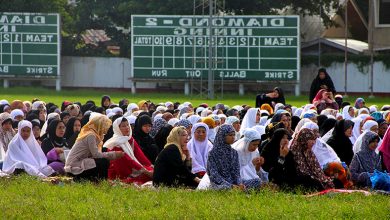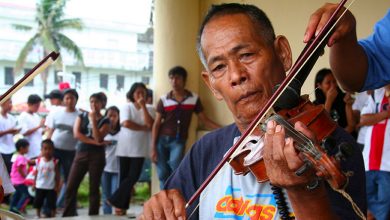Agriculture
Agriculture, along with fishing and forestry provides a living for 46% of the population and accounts for 13.8% of the Gross National Product (GNP) of the Philippines as of 2007. In many areas, like the Cagayan valley, Ilocos plain, Bicol region on Luzon and the central part of Cebu, the land has suffered severe erosion as a result of the heavy rainfall and large-scale forest clearance. There is, however, good soil in areas with volcanic deposits and recent alluvium and on certain sedimentary rocks. Arable farmland comprises more than 16 million hectares, over 9 million are under cultivation, and of these 70% are devoted to subsistence crops. Commercial crops take second place in importance.
Among subsistence crops, rice, the staple food of the Philippines, accounts for some 3.5 million hectares, despite of this the country is the world’s 4th largest importer of rice, after Indonesia, Nigeria and Iran.
In 1990, rice accounted for 27% of value added agriculture and 3.5 percent of GNP. Various cultivation methods are in use. A small part of the total crop is produced without the use of irrigation, including some grown under the archaic slash-and-burn system (caingin) which is still employed for all food crops in the Cordilleras of Luzon. In this method part of the forest is burned down, so that the soil is broken up by the fire and enriched by the ash; the seed was sown with a kind of hoe, and after some years of cropping until the soil was depleted the farmers move on to another site. This is one of the main causes of the destruction of the forests in mountain and hill regions. More usually the rice grown without irrigation comes from fields which are plough with a rudimentary plough drawn by a carabao.
Most of the country’s rice, however, is grown in irrigated fields, either in the plains (rice-fields cover, for example, most of the central plain of Luzon) or on terraces, like those of the Bontocs, Ifugaos and Kalingas in the Cordillera Central of Luzon. The terraces are constructed and maintained by joint effort, using very ancient techniques, like the changa system in which the whole able-bodied population of one or more villages, using rudimentary implements clear a stretch of mountainside, divert the upper course of a small stream to the place where the terraces are to be constructed and build a dam of stones and beaten earth at the foot of the slope. The water flowing down the hillside carries down the finer particles of soil, which are then caught by filtration in the dam. The soil is then carried up again on the peasants’ backs and used to form the terraces and the depressions in which the rice will later be planted. Given the violent rainfall and the frequent cyclones in these areas, it is easy to imagine the immense care and effort involved in constructing and maintaining these rice fields, relatively unproductive as they are.
In the Philippines as a whole, rice yields were very modest until the 1960s, with one crop a year in non-irrigated fields and two crops a year with irrigation. In the last two decades or so, considerable progress has been made. The area occupied by rice-fields has been increased with the development of irrigation, made possible by the construction of a number of large dams like the Agno and Magat Dams on Luzon. In addition experimental stations have been set up at Los Baños (Laguna), where under the aegis of the International Rice Research Institute and with financial assistance from the United States, new species of miracle rice (IR-8, IR-5), with three times the previous yield, have been developed. Thus it is now possible in the Manila plain to obtain three crops a year, in spite of the rudimentary implements used and the antiquated methods of cultivation, frequently on a collective basis. Just before the harvest the peasant selects part of his field (punlaan) to take the plants for the next crop. While the young shoots are developing he prepares the rest of his field, ploughing, pulverizing and fertilizing the soil, all this with the help of carabaos. After about three weeks the field is irrigated, and the shoots are taken from the punlaan, tied in small bundles known as bugkos and handed over to the planting-out teams, who traverse the field in lines. After another three or four month, the peasant weeds the field from time to time and applies a final dressing of fertilizer, the water is drained off and the harvest can begin. The rice is cut with a special knife (yatab), tied in sheaves of palay, loaded on to sleds drawn by carabaos and brought back to the village, where the sheaves are dried and the rice is threshed and husked and finally laid out to dry in front of the house sometimes on the very edge of the road.
Maize, which occupies 3.3 million hectares, is another subsistence crop particularly in Cebu, Leyte, Negros, the Visayas and northern Mindanao. Production is sufficient for the country’s needs, with up to four crops a year in certain areas, though it is frequently still grown by the relatively unproductive caingin method, in association either with non-irrigated rice or with other food crops like manioc, beans or sweet potatoes (camotes).
European visitors may be surprised to find in the supermarkets of Makati (Manila’s shopping district) all kinds of temperate vegetables and fruits. These come from the mountainous provinces in the Cordillera Central, particularly in the Benguet, area near Sagada, the same terraces which serve as rice-fields in Ifugao territory are used to grow temperate crops: hence the mountains of cabbages and potatoes to be seen in Manila.
Cash crops grown for export also play an important part in the agriculture of the Philippines. Sugar-cane is at present in a state of crisis as a result of the collapse of world sugar prices. It is grown mainly by small tenant farmers or sharecroppers, but land reform has not yet made any real inroads on the large plantations, American- or Filipino-owned, in the central Visayas (Negros, Panay, Cebu). The Philippines produce 47% of the world output of copra, the dried kernel of the coconut; this comes mainly from south-eastern Luzon and Mindanao. Formerly almost the whole output was exported, factories for the treatment of copra and coconut oil are now being developed on the spot, particularly in Mindanao. The Philippines also have a practical world monopoly of abaca or Manila hemp, which comes from the family of Musaceae (banana family) and is used mainly in the manufacture of ropes for shipping.
Tropical fruits like pineapples and bananas, grown mainly on Mindanao (pineapples in the Cagayan de Oro area), are exported principally to Japan. Tobacco is one of the oldest established commercial crops in the archipelago, having been introduced by Spanish missionaries in the 16th century. Cigar tobacco (used in the much esteemed Manila cheroots) is mainly grown in the middle Cagayan valley in rotation with maize. More recently cigarette tobacco (Virginia) has been developed in the northern part of the central plain and on the Ilocos plain; in the latter area, around Vigan almost every farm is flanked by its tobacco-drying tower, of varying design and material (frequently bamboo). Other commercial crops, of minor importance, are coffee, maguey (a kind of agaves), ramie, kapok and rubber.
Most of the produce, both subsistence and commercial crops, comes from small holdings. In contrast to other tropical countries, there are very few large plantations of several thousand hectares. One of the largest such estates, 6,000 hectares of pineapples in northern Mindanao, is owned by the Philippine Packing Corporation, a subsidiary of the California Packing Corporation, better known as Del Monte; it is a world on its own, with its own schools, hospitals and shops. The normal peasant holding is small (between 3 and 4 hectares on average), and does not usually own the land: he is a sharecropper on a large hacienda, paying a high rent (ranging between 30% and 70% of his crop), heavily indebted and with a wretchedly low standard of life. The land reform which made a timid beginning in 1963 has largely foundered on the resistance of the powerful landowning oligarchy. The result has been a steady drift of population from the country to the towns, particularly Manila.




